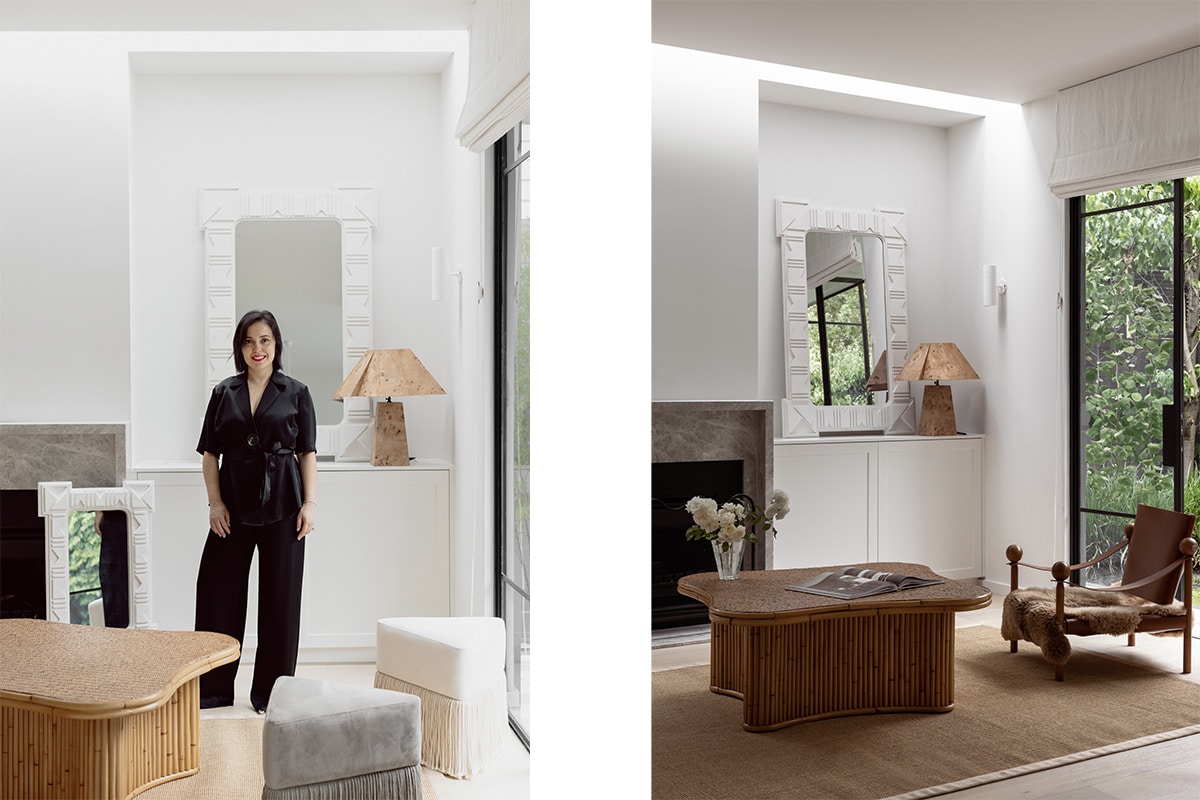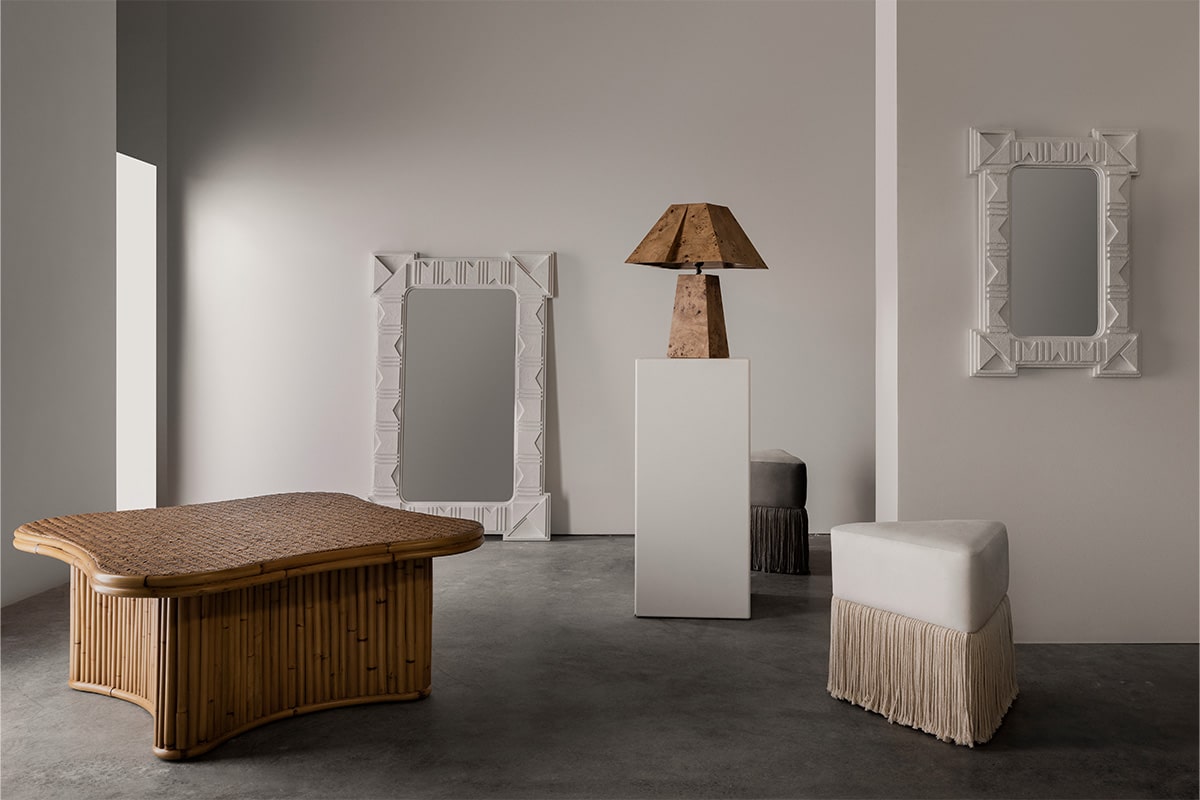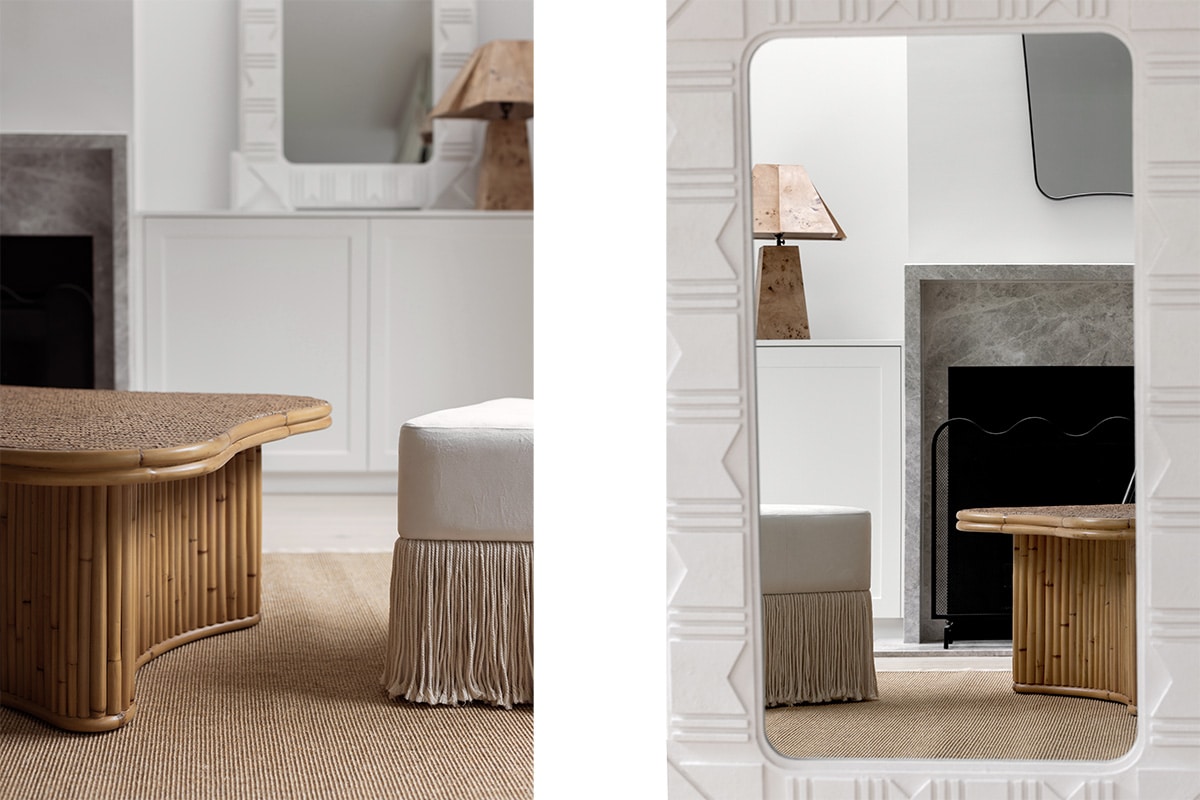
Rachel Donath is a woman who knows what she likes. It's a quality the Melbourne-based furniture designer credits her success to. She's never been swayed by interior trends, designer names or shiny objects. Donath believes the most striking spaces convey a confident expression of the personalities and people who inhabit it. They're anything but cookie cutter. Which is something that can be said about the quality furniture that's become synonymous with her name. It's objects as art. Slow furnishings. Quality pieces made in good conscience and with intention.
In the years since Rachel Donath pivoted to a career in furniture design, she's become a beloved source for interior pieces that make your heart skip a beat. Ahead of the launch of her recent collection, entitled Forme, RUSSH caught up with Donath. Below, she shares her first memories of interior design and why you should never ask for someone's opinion on a piece you love.
Can you tell me about the philosophy of Rachel Donath?
The philosophy of Rachel Donath is about creating sculptural, collectible furniture pieces. It's about slow furnishings. It's about furniture that is artwork. In my view, I see furniture as contemporary heirlooms pieces that someone will hopefully have for many, many years to come. They're timeless and don't align with any particular trends. It's quality and unique design that stands the test of time, both aesthetically and structurally.
Do you remember the first time you were struck by interior design?
I've got family members who are really creative people. They are collectors who are well-travelled and well-educated, in terms of being fortunate enough to have exposure to amazing artists, literature and architecture. So growing up, I was very lucky to have family members that lived in homes that were not necessarily big, but were so tastefully and carefully created.
The homes that I'm referring to were quite eclectic, they never fit any mould. You would never see any piece in there that was stock standard. They were very unique, bold, and true to the people and personalities who lived in the house. I was drawn to that really confident expression of self. It's also who I am as a person; I don't care very much for trends, I don't care for fads, I don't care for what people think in terms of popular opinion. I'm an independent thinker and quite individualistic in that way. I guess being surrounded by other personalities who had a similar mentality is probably what built my confidence and it just set the bar really high in terms of what I saw as a beautifully created home. I was able to differentiate from a very early age that what I saw was personality. That is was someone who's got great taste.
It's a whole new way of living. It's really about living truthfully to who you are. It's about living in a way that embraces the things you love and care about. It's a mindset of learning and being open to more knowledge. It's not having to explain yourself to anyone and having the confidence to not care is someone thinks you're weird or crazy.
Can you tell me about how your business came to be? I know you began it back in October 2020.
The business was born as a result of Covid-19 and during lockdown. So in that way, I'm grateful for what came from what was a very difficult time. I was working in marketing and PR – I'd been doing that for 15 years – and I was good at it. But Covid-19 came and it offered time to reflect. I just felt that I was heading towards 40 and I've always loved interiors, creativity, sourcing, selecting and finding beautiful things and putting them together. But I never thought it was something that could become a business. I always thought it would just be a hobby.
Then I was home a lot with lockdowns in Victoria and I just decided to try and sell a few vintage pieces that I'd sourced myself but hadn't worked in my space on Instagram. At the time I had 200 followers. Then a popular interior designer started following me in the first two days and buying from me. And not long after I had some other big players in the Australian design industry reaching out and asking me to source for them. It made me realise that it's more than something that I love, it's something that other people appreciate as well. Having that recognition gave me a lot of confidence, which is what helped me eventually put pen to paper and start designing some of my own pieces.
I think the key for me is to stay true to myself and my aesthetic. I've never designed and curated with a trend in mind. It's never been about what people will buy. It's always about what makes my heart skip a beat, what I think is an incredible sculptural piece.
What were you consuming while creating your latest collection Forme?
I went on a skiing trip to New Zealand last year and it was my first time ever to the country. I was blown away by nature there; the snow-capped mountains, the colours, the shapes. I just remember sitting at the onsen and looking over the snow-capped mountains and taking maybe 100 photos on my phone. I just wanted to remember the colours.
So that formed a lot of the ideas behind the shapes of the collection. We've got the DuPont Bedhead which has the peaks and we've got the Ottoman which is a triangle. Every single piece was really based on an experience, a vision, something I see, something I feel.
It's created how an artist would create an artwork; there's a lot of intention behind it, there's always a story behind it. Every piece has a story.
What's been the most surprising element of having your own business?
There have been a lot of aspects that are new to me, like logistics. which, I mean, I never really, I mean, I've run a marketing business before, which has no logistics. Having product, there's shipping and huge moving pieces in terms of getting everything where you needed to be, by certain timeframe. So this has all been a huge learning curve for me. It's not something that I didn't know would happen, but it was something that I had zero experience or knowledge about. So that's been challenging. But I think I've been good at finding the right people in these industries to guide me and I learn a lot from other people.

Can you tell me about the manufacturing process at Rachel Donath?
So in Australia, my manufacturers are all within a 5km radius of my warehouse, like my upholsterer is literally across the road. It's very much a community which I adore. My warehouse is in an industrial area in Bayside in Melbourne and there's a lot of different types of artisans and craftspeople in the area. My stonemasons around the corner, my welder is within walking distance. It opens opportunities for discussion, which I really value. Every idea I've ever had has been improved by 20% from the input I've had from the artisans that I work with, because at the end of the day they know their craft way better than I do.
We're very selective about the manufacturers we work with overseas. We've got a very strong sustainability focus and we only want to work with manufacturers who are aligned with that focus. Fair pay and good working conditions are no brainers, but there are also things to consider like recycled timbers, using non toxic glues and ethically sourced fabrics. Basically just trying to do the right thing, which hopefully translates to the final product. There's good conscience behind each piece. Nothing has been made at the expense of a person or part of the world.
Are there any design movements of figures that you're inspired by?
I have to say the pieces that I see and love the most don't have a name or genre attached to them. I love going through old auction catalogues from all over the world – some people watch Netflix at night and I go through auction catalogues. Often I'm trying to find the name of the artist and it doesn't actually say who it's by, it's nondescript.
I'm not swayed by the idea that "it's a famous person that made it and therefore it's great". I look at the piece for what it is, I don't really care about the brand. And because I have that mindset, I can also find something that's made by someone in their garage 20 years ago for their child and think "this is genius". I mean there's a lot of amazing work out there but I definitely have a broader idea of what makes something beautiful.
What’s the best business advice you’ve ever received?
I just subscribed to Masterclass, which I'm loving. I can't even think about who said it because I've watched so many but something that stuck with me was the idea that you should stay focused to the authentic purpose behind the business; staying connected to your audience and staying humble is so important.
Another one I heard Sara Blakely say was this idea of hiring your weakness, which I thought was so smart as I'm in the process of growing our team at the moment.
What is your favourite part about curating a space? Do you have any advice for those looking to do the same?
My favourite part of creating a space is not giving a shit about what other people think. Never ask someone else what they think of a piece. That's kind of one piece of advice I would say. Never ask someone else, because you'll find something that you love and you'll show it to someone and they'll be like, "that is so weird". I think as soon as you start letting other people influence what your creating is when you begin curating a really filtered down space.
I think that to create a space that's incredible you've got to really focus on your vision; have that confidence to do things alone and just don't rush it, take your time. It's better to have an empty space or in my opinion, I'd rather use folding chairs, then settle for something I don't love. I'd rather wait for the right thing. At the same time, if you find something that's amazing that you don't have the space for yet, as long as you got somewhere to store it, buy it. Fill your house with the things you love.

Are there any artworks or artists you're coveting at the moment?
I love George Raftopoulos – I've loved his work forever. I'm still looking for the perfect large scale piece for my home office but I refuse to settle and get something that I don't love. I'd rather like wait two more years to I find the perfect piece. I also love a lot of Indigenous art, and sculpture. I'm lucky to own a few beautiful pieces that I've collected slowly over time. But I also love pieces you find at auction houses that are by no-ones, they're not famous but you still think they're genius. Those are special too.
In 2023 I’d like to see less… and more…
Less same same. Less cookie cutter. More personality. I would love to see more individuation of spaces and confidence of of individual design. But then again whatever makes you happy, you know what I mean?
What are you manifesting for 2023?
Last year I manifested generosity. This year I'd like to soar. I feel like I sowed a lot of seeds and I like to see some of that come to fruition. I would like to see more opportunities come my way and make good decisions with ease. I would like the business to grow in a beautiful way and be received and seen for what its mission is: which is to bring beauty into people's homes.



